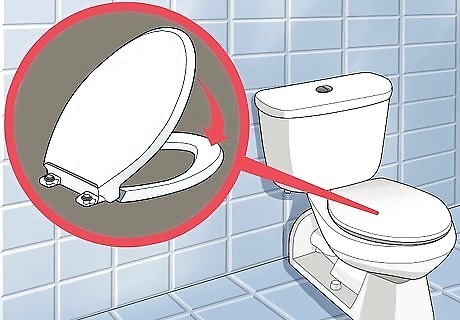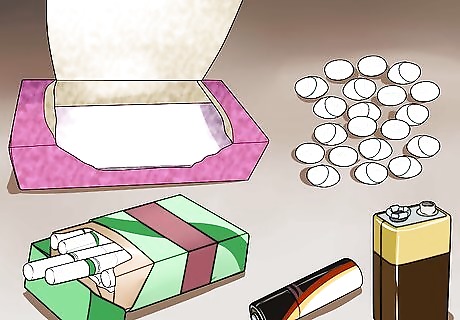
views
Checking Your Apartment and Changing Your Habits

Test your screens. If you open your windows often, check to make sure your screens don't give easily under pressure. Some screens will pop out, letting your cat escape or even injuring your cat if it falls out of a second- or third-story apartment. If your screens do pop out, only open your windows a crack or ask your management staff if they can be changed out.

Always check your dryer and dishwasher. Cats have a tendency to go where it's warm. When you're done using these appliances, make sure you close them so that your cat doesn't crawl in and get trapped. In addition, always look inside before you run them.

Cover your trash cans. Some cats will decide they want to explore what's in your trash can, either digging out unsavory items that make them sick or knocking the can over. They could also be cut on items, such as can lids. An easy solution is to get a can with a lid. Switching from metal to plastic trash cans should do away with sharp edges

Put the lid down. Cats, especially kittens, can drown in a small amount of water, including your toilet bowl. In addition, older cats may want to drink from the not-so-clean water. It's best just to put the lid down when the toilet's not in use.

Check your furniture. If you have furniture that reclines or has a lifting foot, always check underneath before putting it up. Cats love crawling in tight spaces, and you don't want to trap yours.

Don't leave candles unattended. Cats can catch their fur on fire when they walk by. Make sure you are always nearby when you have one lit.

Tell your management about your cat. While you may want to hide your pet to avoid paying a deposit, it's important to warn management about your pet. Because management may enter your apartment in an emergency, they should know you have a pet, so they don't let it out accidentally.
Removing Hazards

Check for poisonous plants. Many plants are poisonous to cats. Some are only mildly so, while others can be deadly. Check each plant in your house to make sure they are not poisonous to your cat. It's best to take out poisonous plants altogether, but if you must keep them, put them in a room the cat is not allowed in. Some common plants that are poisonous include Aloe Vera, any type of lilies, many types of ferns (though not all), calladium, and many ivies. Some non-toxic options for cats include African violets, bamboo, and feather palm.

Keep poisonous foods out of reach or put away. You shouldn't have coffee, alcohol, chocolate, grapes, or raisins where your cat can eat them. In addition, you shouldn't let your cat try yeast dough, macadamia nuts, onions, garlic, chives, or xylitol, as they can also cause problems. Though it's common lore that cats like milk, you shouldn't feed it to them because the lactose can cause stomach issues. Finally, avoid feeding your cat extra salt, as she may not be able to process it properly. This list isn't comprehensive. Always check to see if a food is safe to feed your pet by using high quality websites or asking your vet.

Put up any strings. Strings, such as the ones on blinds, are enticing to your cat. They look like perfect toys to her. However, she can get tangled up in them or even strangle herself. Your cat also might be interested in cords for electronics, which have an obvious risk if she chews on them. Hide them or tie them up high when possible. Don't forget to hide strings such as dental floss or yarn. While you can use them to play with your cat, if you leave her unsupervised with these items, she can swallow, which can cause stomach problems. If you can't get them out of reach of your cat, you can make them taste bad. Use a cat-safe spray, such as bitter apple.

Hide the chemicals away. Cleaning supplies and other household chemicals are often poisonous to cats, and your curious cat may try to get into a bottle if she can find one. Therefore, make sure you keep them put away in cabinets that your cat can't get into.

Hide medicines. Like chemicals, medicines can be poisonous to your cats. Even if it's a medicine your cat can normally take, it will be a much higher dose than she would need. Unfortunately, your medicine bottles may sound like a cat toy to her, and she may play with it until it pops open. Put them away in a medicine cabinet or cat-proof box, such as one with snap handles.

Remove other toxic items. Some common household items are toxic to your cat, ones you wouldn't think about. For instance, mothballs and fabric softener sheets can be toxic. In addition, cigarettes and batteries can also cause your cat problems. Make sure to keep these out of your cat's reach.
Protecting Your Things and Your Apartment

Provide appropriate scratching places. If you live in apartment, you want to protect it from your pet. Therefore, make sure you provide a place for you cat to scratch that's not the carpet. You can find inexpensive scratching boards at any pet store; some are even made out of cardboard.

Take down breakables. If you have knickknacks that are breakable, it's best to hide them away, even if you think they are out of your cat's reach. She is a curious creature, and she will climb onto places you wouldn't expect, knocking off your breakables. Not only will you lose the knickknacks, your kitty could get hurt on broken shards.

Clip your cat's claws. Clip your cat's toenails on a regular basis. That will help protect your furniture, plus it's better for your cat. If her claws aren't trimmed, they can cause pain for your cat. You don't need a special tool to trim your cat's claws, though you can buy one. You can just use regular nail clippers, as long as they're sharp. Have cornstarch, styptic powder, or a bar of soap near by to stop bleeding (rub them on the bleeding part), though the claw shouldn't bleed if you do it correctly. Grip your cat under one arm, while gently grabbing a paw. Press on the cat pad to extend the claw, then clip the nail, making sure to avoid the "quick," the pink part, which has nerve endings. Trim the rest of the claws. It may take several sittings to get them all. Do not declaw your cat. It's unnecessary, and cruel. A cat's nails are basically part of their toes, and removing them can cause pain and behavioral issues.

Cover your furniture. A cat sheds. That's a fact of life. While you can't stop a cat from shedding, you can find covers for your furniture. They may not be the prettiest option, but you can pull them off when company comes over. Plus, you can wash them periodically.














Comments
0 comment